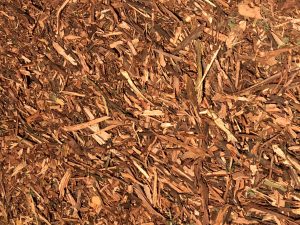The cooler months are great for doing those jobs like mulching in preparation for a long hot summer.
Mulching the entire drip line underneath this group of trees will improve tree health and alleviate the need to mow the grass underneath, which can potentially damage trunks and exposed roots. Most trees concentrate the main stream of their small absorbing roots in the upper 150mm of soil if the surface is sheltered by a good spread of mulch (50-100mm) or ordinary forest litter. Exposed bare soil can develop heat near the surface of the roots and result in no root growth in the upper 200-250mm.
Sources of mulch
Mulch should be from chipped-up trees, yielding variously-sized pieces. Green mulch is acceptable if it is allowed to rest for two weeks and is hosed down with water and sprinkled with blood and bone. This mulch must not contain grasses or high nitrogen materials, nor should it be hot to touch.
Nitrogen drawdown
This can occur if ‘hot’ mulch (that is, green or humus-rich mulch) is laid over bare soil. Micro-organisms present in hot mulch draw nitrogen from the soil, possibly stressing the tree roots. Best practice is to use mulch that has undergone pasteurisation by allowing it to sit for six weeks and regularly turning it over prior to use. This process can be sped up and the time required reduced to two weeks if the mulch pile is watered daily and sprinkled with blood and bone. The recommended mulch is coarse in structure, having at least 70% by mass of its particles with a maximum size of greater than 16mm.
Benefits of mulch
Where there is open soil and shrub-planted areas near trees, mulch is the preferred surround because it will:
- inhibit weed growth
- reduce groundwater evaporation
- resist soil compaction and therefore allow the vital exchange of gases in the soil
- increase macro pores, which improves water penetration
- reduce maintenance requirements
Good mulching practice
- Ensure the area is well-watered before applying mulch.
- Depth of mulch needs to be between 50 –100mm.
- Do not use ‘hot’ mulches. These are biotic and not yet broken down, so will extract nitrogen from the soil.
- Ensure mulch does not form an impermeable mat.
- Do not use mulch made from an allelopathic species (e.g. black walnut)
- Avoid using peat-based mulch because it’s unsustainable.
by Steve Griffiths, Level 5 arborist, Canberra

mulch should be put on 7-10cm deep
